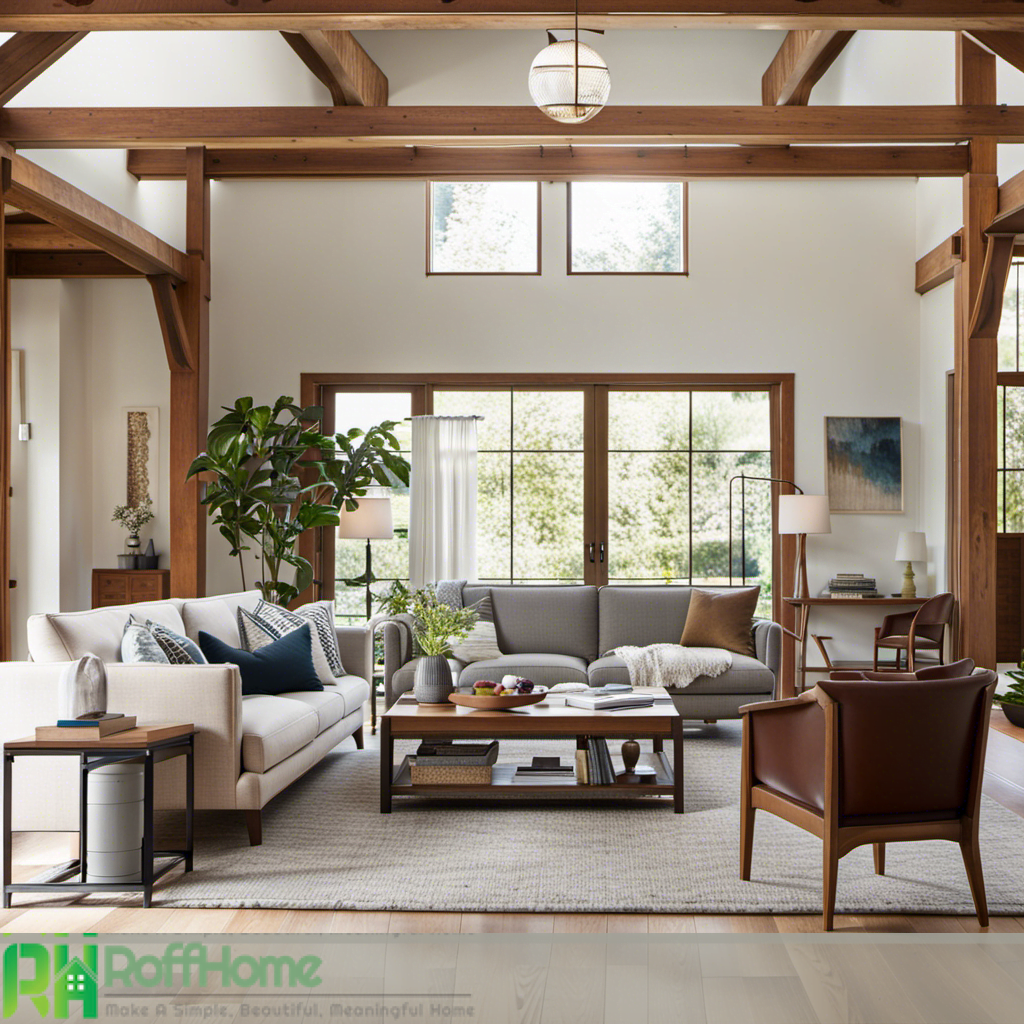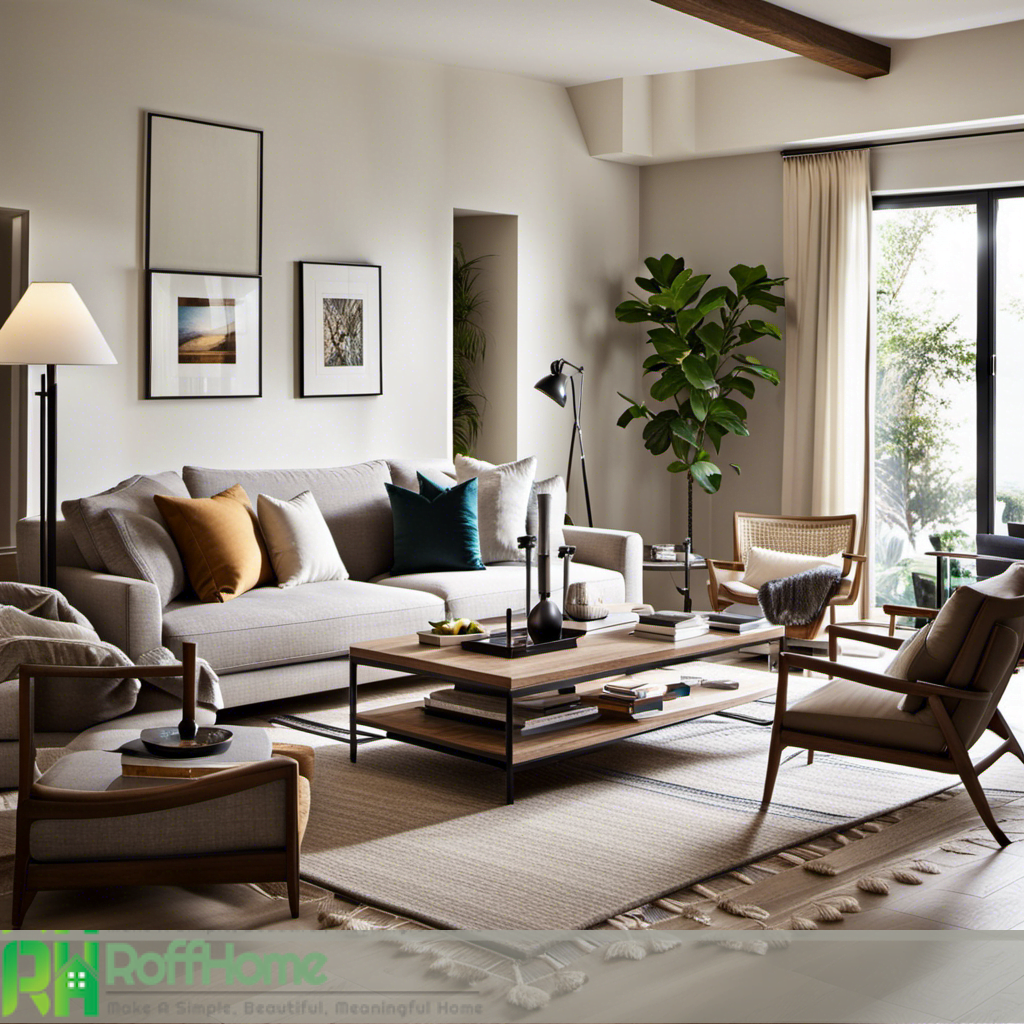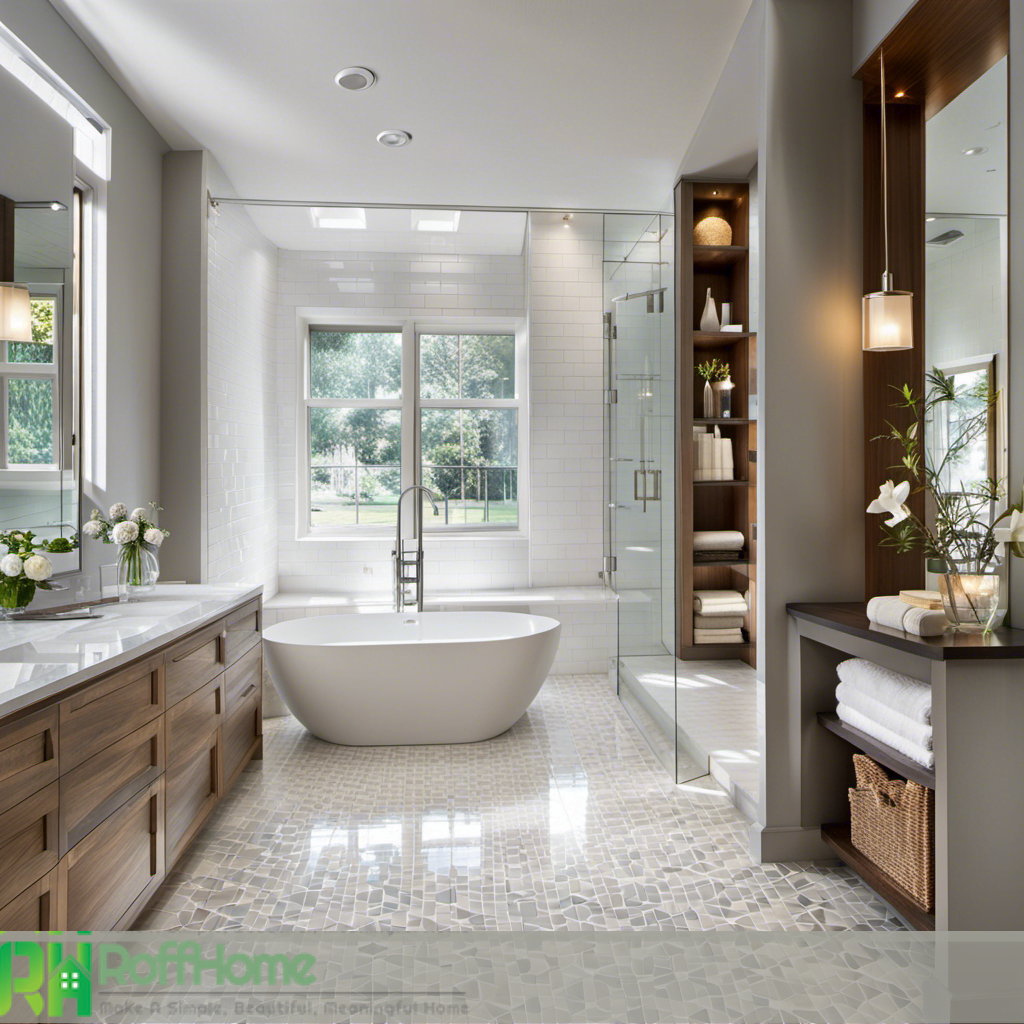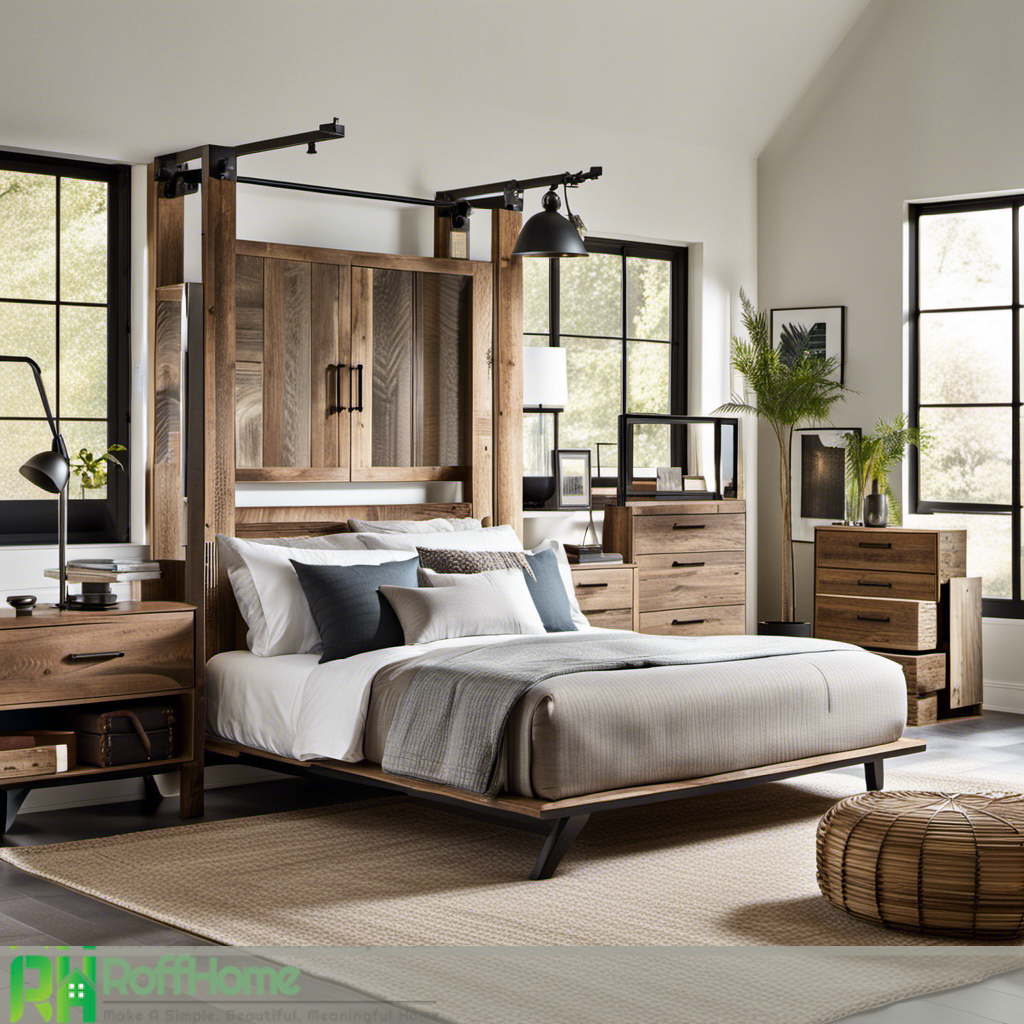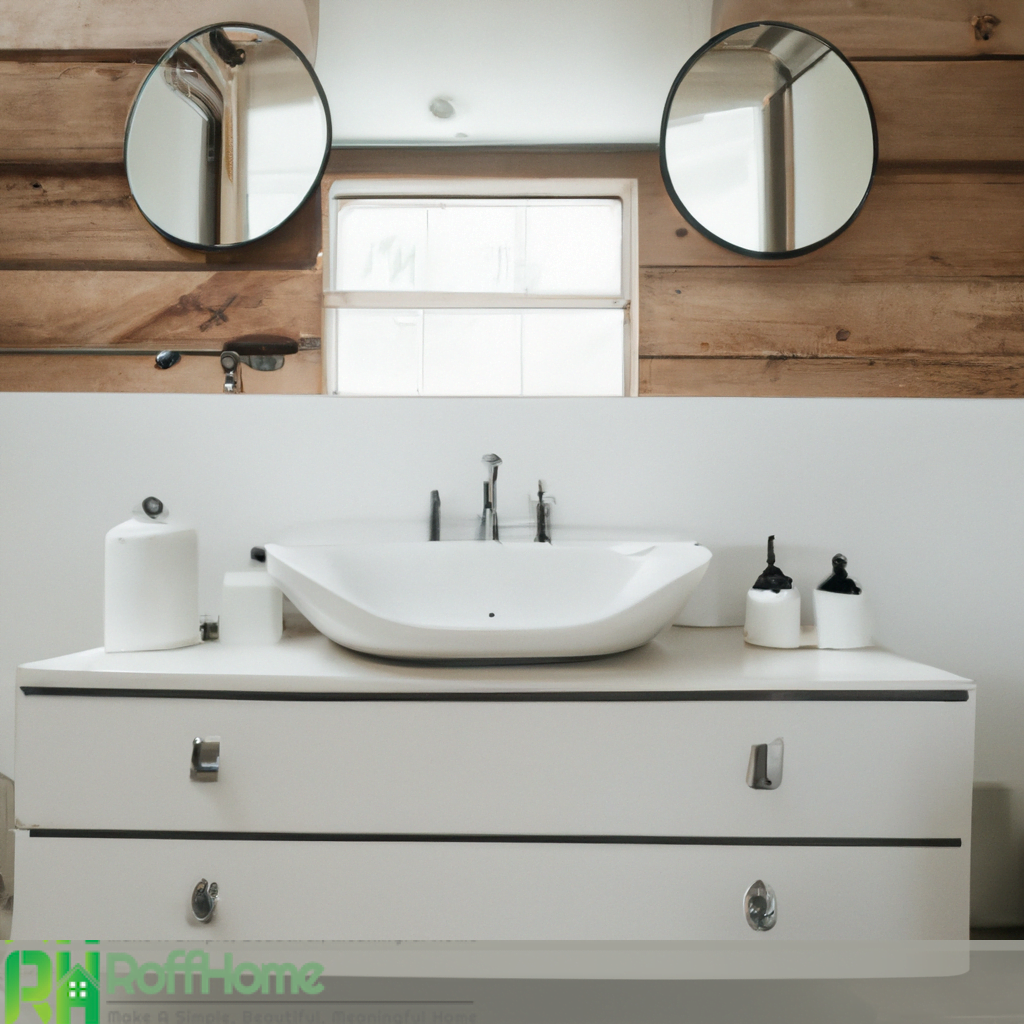Inspiring Transitional Modern Living Room Ideas for a Timeless and Stylish Space

A transitional modern living room is a harmonious fusion of traditional and contemporary design elements, creating a space that exudes style and functionality. This type of living room design seamlessly blends the classic elegance of traditional decor with the sleek lines and minimalist aesthetic of modern interiors.
One of the key aspects of a transitional modern living room is carefully selecting a color palette and materials. The color palette often combines neutral tones with pops of vibrant hues, creating a sense of warmth and visual interest. When it comes to materials, a mix of natural textures such as wood, stone, along with sleek finishes like glass and chrome, adds depth and character to the space.
Furniture selection is another crucial element in achieving the desired look. The furniture in a transitional modern living room balances classic and contemporary styles. It may feature clean lines and minimalist designs, incorporating traditional elements like tufted upholstery or ornate detailing. This blending of styles creates a unique and inviting atmosphere.
Textiles and patterns add texture and personality to a transitional modern living room. These elements, from plush area rugs to decorative throw pillows, introduce visual interest and create a cozy and inviting atmosphere. Art and accessories are carefully curated to reflect the homeowner’s style, adding a personal touch to the space.
Transforming Living Room: From Traditional to Transitional Modern Style
Transforming a living room from a traditional design to a transitional modern style can breathe new life into the space and create a harmonious blend of classic and contemporary elements. This transition involves reimagining the room’s aesthetics and incorporating key design principles to achieve a cohesive and stylish look.
In traditional design, ornate details, rich colors, and formal furniture pieces are commonly found. However, transitioning to a transitional modern style requires embracing modern design elements characterized by clean lines, simplicity, and minimalism.
One of the fundamental aspects of this transformation is selecting an appropriate color palette and materials. Neutral tones serve as a base, while pops of color can be introduced through accessories and accent pieces. Wood, metal, glass, and textiles add texture and visual interest to the room.
Furniture selection plays a crucial role in achieving a transitional modern style. Balancing classic and contemporary pieces is essential, as it helps create a cohesive aesthetic. Retaining some traditional furniture while incorporating modern elements brings a sense of balance and uniqueness to the space.
Effective lighting and thoughtfully chosen accessories further enhance the transformation process. Proper lighting design can create a warm and inviting ambiance, while carefully selected accessories, such as artwork, rugs, and decorative items, add personality and character.
The layout and space planning of the living room should be optimized for functionality. Considerations such as traffic flow and creating distinct zones for different activities are important. Additionally, incorporating transitional patterns and textures through upholstery, curtains, and cushions adds depth and visual interest to the space.
Creating a focal point is another key aspect of the transformation. This can be achieved through a striking fireplace, an accent wall, a piece of artwork, or a well-curated furniture arrangement. The focal point anchors the transitional modern style and becomes a captivating feature in the room.
Lastly, budget-friendly tips can help homeowners achieve their desired transformation without overspending. Repurposing existing furniture and accessories, seeking affordable alternatives, and incorporating DIY projects can make the process more cost-effective while still achieving a stunning result.
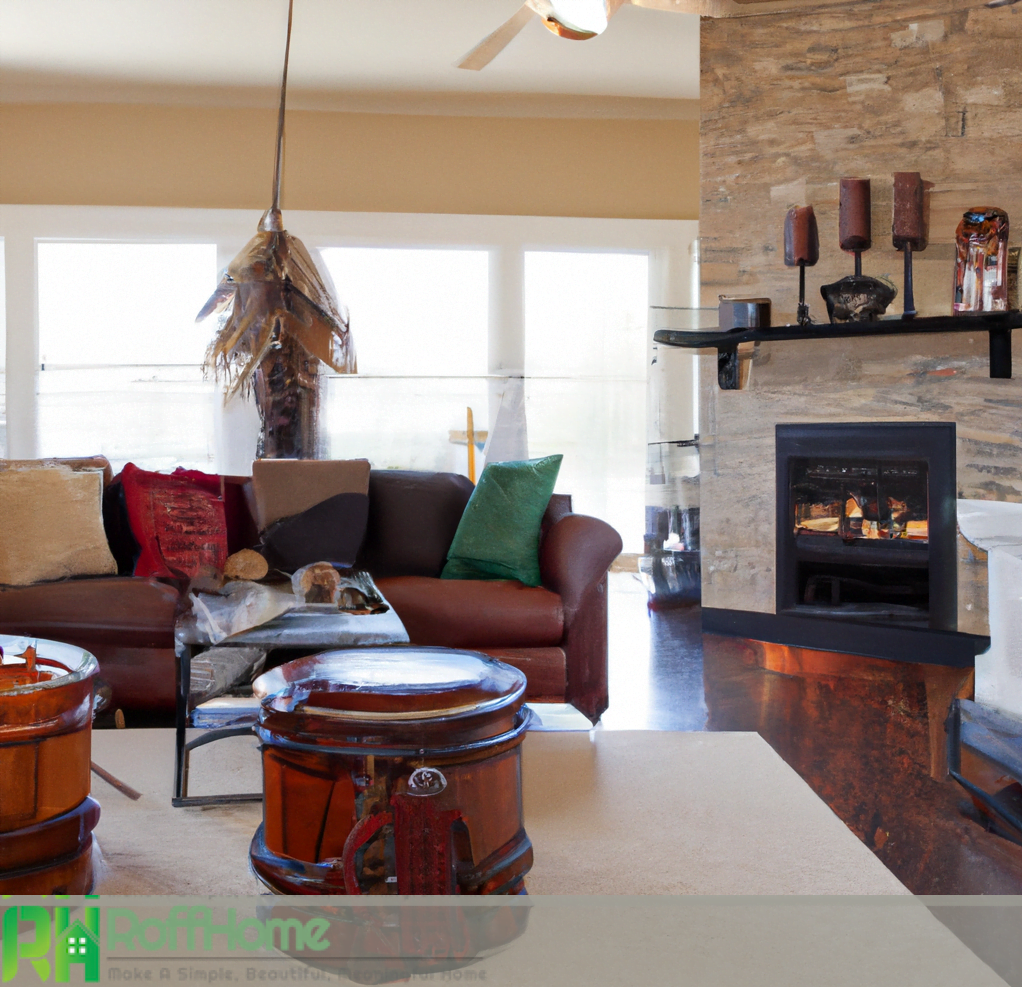
Understanding the Concept of Transitional Modern Living Rooms
Transitional modern living rooms have gained popularity as a design style that seamlessly blends traditional and contemporary elements to create a harmonious and timeless space. This concept combines the elegance and warmth of traditional design with clean lines and simplicity of modern aesthetics, resulting in a unique and inviting atmosphere.
It is essential to delve into its core principles and characteristics to grasp the essence of transitional modern living rooms. This design approach seeks to balance old and new, showcasing the best of both worlds while avoiding extremes.
One of the defining features of transitional modern living rooms is the careful selection of color palettes and materials. Neutral tones, such as beige, gray, and cream, are often used as a base to create a calm and serene backdrop. These colors provide a versatile canvas for pops of color through accessories or accent pieces.
Furniture selection is crucial in achieving a transitional modern style. In these living rooms, furniture pieces often combine contemporary silhouettes with classic detailing. Clean lines and simple forms are common, while traditional elements, such as tufting or ornate carvings, may be incorporated to add a touch of elegance.
Lighting design plays a significant role in creating the desired ambiance in a transitional modern living room. Ample natural light is welcomed, complemented by well-placed artificial lighting fixtures. From statement pendant lights to recessed lighting, the goal is to achieve a warm and inviting atmosphere while highlighting key features and creating visual interest.
Accessories and decor are thoughtfully curated to reflect the homeowner’s style and add personality to the space. Artwork, decorative objects, and textiles are essential in introducing color, texture, and visual focal points. The goal is to balance simplicity and curated detail, allowing these elements to enhance the overall design without overwhelming the space.
Layout and space planning in transitional modern living rooms emphasize functionality and flow. Flexibility in furniture arrangement is key, allowing for easy transitions between socializing, relaxation, and entertainment areas. A well-designed layout optimizes space utilization while creating a sense of openness and comfort.
The Key Features of a Transitional Modern Living Room Design
A transitional modern living room design incorporates key features that create a seamless blend of traditional and contemporary elements, resulting in a stylish and harmonious space. Understanding these features is essential for achieving an authentic transitional modern look.
Balanced Color Palette: A balanced color palette is a key aspect of modern transitional design. Neutral tones like beige, cream, gray, and taupe are often used as a foundation, creating a calm and versatile backdrop. These neutral colors are complemented by pops of color introduced through accessories, accent furniture, or artwork, adding depth and visual interest.
Fusion of Materials: Transitional modern living rooms often feature a fusion of materials. The design combines natural materials like wood, stone, and leather with sleek finishes like glass, chrome, and polished metals. This combination adds texture and creates a dynamic interplay between traditional warmth and contemporary sophistication.
Merging Furniture Styles: Transitional modern design harmoniously merges furniture styles from different eras. It combines clean lines and simplicity of contemporary furniture with the timeless elegance of traditional pieces. This blending of styles creates a unique, comfortable, and visually appealing aesthetic.
Focus on Comfort: Comfort is a priority in a transitional modern living room. Plush seating, soft fabrics, and cozy textures create an inviting atmosphere. Upholstered furniture with a mix of classic and modern designs offers style and comfort, ensuring an enjoyable space for relaxation and socializing.
Streamlined Silhouettes: Transitional modern design favors streamlined silhouettes and avoid excessive ornamentation. Furniture pieces typically have clean lines and simple forms, reflecting the minimalist aesthetics of contemporary design. This clean and uncluttered look contributes to the overall sense of sophistication and elegance.
Thoughtful Lighting Design: Lighting is crucial to transitional modern living rooms. Strategic placement of lighting fixtures, including pendant, recessed, and floor lamps, creates a well-lit space with layered lighting effects. This enhances the ambiance and highlights key design features, such as artwork or architectural elements.
A mix of Patterns and Textures: Transitional modern living rooms often incorporate patterns and textures to add visual interest and depth. Subtle patterns, such as geometric prints or botanical motifs, can be introduced through rugs, throw pillows, or curtains. Textures like plush fabrics, natural fibers, and textured wallpapers contribute to a tactile and visually appealing environment.
Thoughtful Accessorizing: Accessories are vital in a transitional modern living room design. Thoughtfully selected artwork, decorative objects, and personal items add personality and character to the space. Careful curation and display of these items create focal points and contribute to the overall aesthetic.
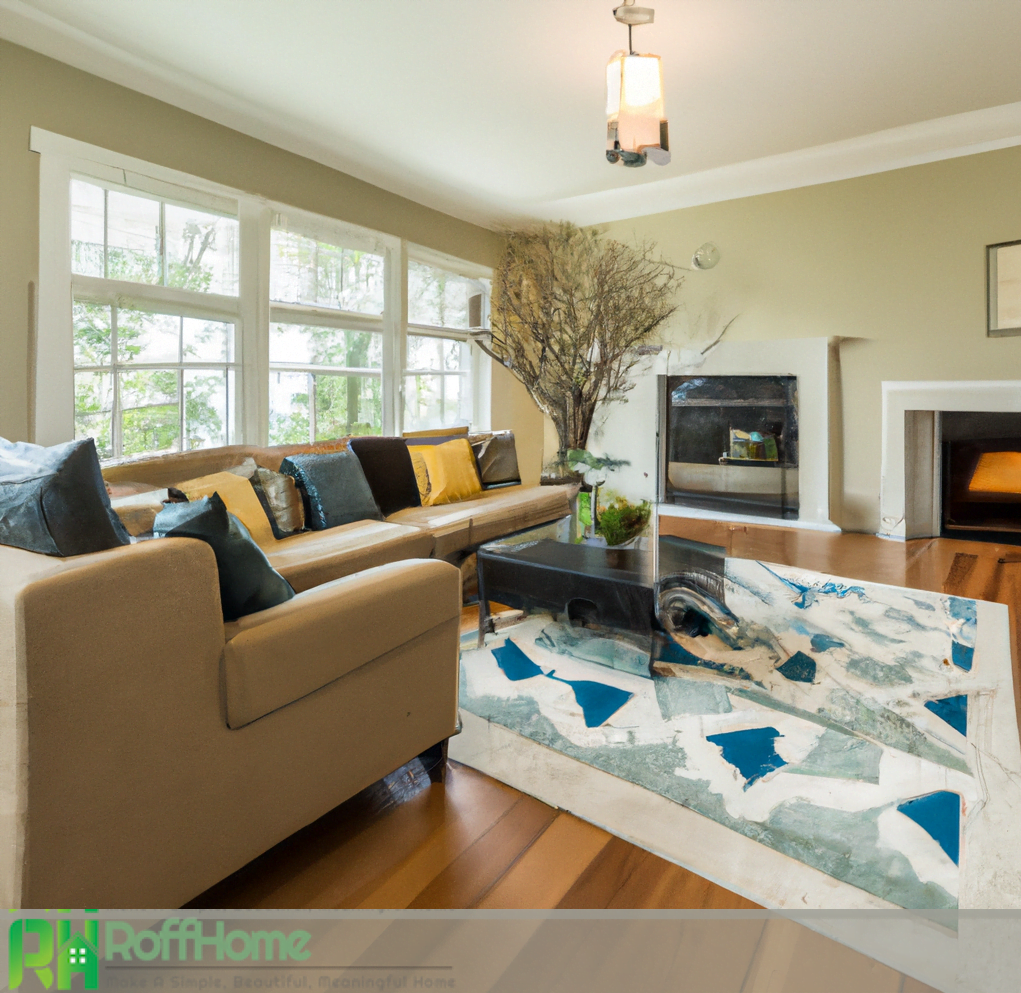
Creating a Cozy and Inviting Atmosphere in Transitional Modern Living Rooms
Creating a cozy and inviting atmosphere is crucial to designing transitional modern living rooms. This approach combines the warmth and comfort of traditional design with the sleekness and simplicity of modern aesthetics. Achieving a welcoming and inviting space requires attention to certain key elements.
Warm Color Palette: A warm color palette is fundamental to creating a cozy atmosphere. Earthy tones like warm beige, creamy off-whites, soft browns, and subtle shades of gray can evoke a sense of comfort and warmth. These colors can be applied to walls, furniture, and accessories to create a soothing and inviting ambiance.
Layered Textiles: Introducing layered textiles adds texture and visual interest while enhancing the space’s coziness. Plush area rugs, soft throw blankets, and cushions made from natural fabrics like cotton create a tactile experience and a sense of warmth. Mixing and matching different textures and patterns adds depth and character to the room.
Soft Lighting: Lighting plays a significant role in setting the mood in a transitional modern living room. Soft and warm lighting creates a cozy and intimate atmosphere. Dimmable lighting fixtures, such as table lamps, floor lamps, or sconces, allow for flexibility in adjusting brightness to create the desired ambiance.
Fireplace or Hearth: Incorporating a fireplace or a hearth in the living room instantly adds coziness and warmth. Whether a traditional wood-burning fireplace or a modern electric one, the flickering flames, and comforting heat create a focal point that invites relaxation and gathering.
Comfortable Seating: Choosing comfortable seating is essential for creating a cozy atmosphere. Plush sofas, armchairs, and ottomans with soft upholstery provide a cozy and welcoming relaxing place. Incorporating oversized pillows or cushions adds extra comfort and creates an inviting seating area.
Natural Elements: Bringing in the natural elements, such as indoor plants or fresh flowers, adds a touch of freshness and vitality to the space. The presence of greenery not only enhances the aesthetics but also promotes a sense of tranquility and connection with nature, contributing to a cozy atmosphere.
Personal Touches: Adding personal touches and sentimental items to the living room creates a sense of familiarity and warmth. Displaying cherished photographs, artwork, or mementos can infuse the space with personality and make it feel more inviting and personal.
Cozy Reading Nook: Creating a cozy reading nook within the living room provides a dedicated space for relaxation and leisure. A comfortable armchair or a chaise lounge paired with a side table and a well-placed floor lamp can create a cozy corner where one can curl up with the book and unwind.
Tips for Styling and Personalizing Transitional Modern Living Room
Styling and personalizing a transitional modern living room allows homeowners to infuse their unique taste and personality into the space. It’s an opportunity to create a room that reflects their style while balancing traditional and contemporary elements. Here are some tips to help style and personalize a transitional modern living room:
Define Your Style: Before starting the styling process, take some time to define your style. Gather inspiration from magazines, online platforms, and interior design websites to identify the elements, colors, and themes that resonate with you.
Mix and Match: Transitional modern living rooms thrive on the art of mixing and matching. Combine furniture pieces from different eras and styles to create an eclectic yet cohesive look. Pair a modern sofa with a vintage coffee table or a traditional armchair with contemporary lighting fixtures. This blending of styles adds visual interest and reflects your unique taste.
Art and Accessories:
- Incorporate artwork and accessories that speak to your aesthetic.
- Choose pieces that resonate with you emotionally or visually.
- Hang artwork that reflects your taste, whether contemporary paintings or traditional prints.
- Display meaningful accessories, such as sculptures, vases, or personal collections, to add personality and character to the room.
Textiles and Patterns:
- Use textiles and patterns strategically to add depth and visual interest.
- Incorporate throw pillows, curtains, and rugs with different textures and patterns.
- Mix solids with prints or experiment with geometric designs, floral motifs, or abstract patterns.
Showcase Memories: Personalize the living room by showcasing cherished memories and experiences. Display family photographs, travel mementos, or sentimental objects on shelves or gallery walls. This adds a personal touch, sparks conversations, and makes the room feel more inviting.
Greenery and Natural Elements: Introduce greenery and natural elements to bring life and freshness to the space. Incorporate indoor plants or fresh flowers in stylish planters or vases. The presence of nature creates a calming and rejuvenating ambiance, enhancing the room’s overall appeal.
Layer Lighting:
- Pay attention to lighting design to create the desired ambiance.
- Layer different lighting sources, including overhead, table, floor, and wall sconces, to achieve a well-balanced and inviting atmosphere.
- Use dimmers to control the brightness and set the mood for different occasions.
Display Books and Magazines: Style your living room by displaying a selection of books and magazines that align with your interests and hobbies. Arrange them on coffee tables, bookshelves, or floating shelves.
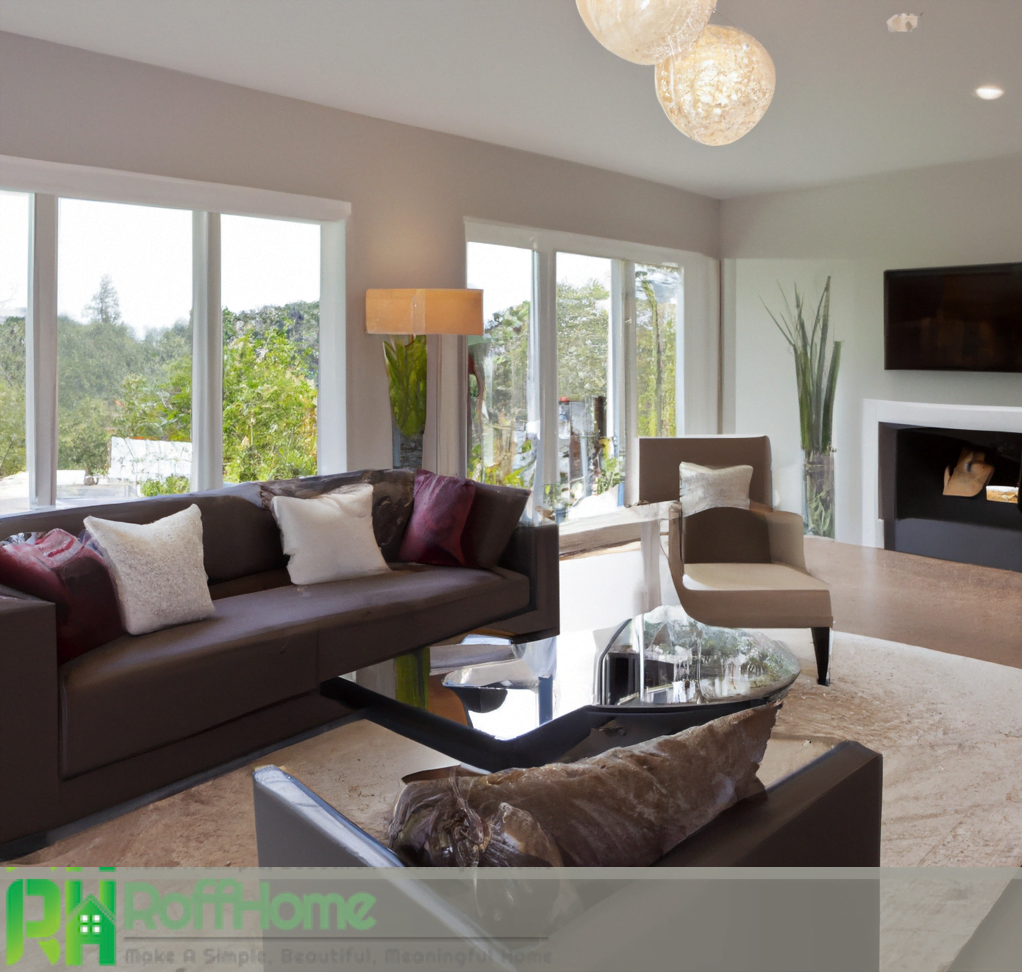
Maximizing Space and Functionality in a Transitional Modern Living Room
When designing a transitional modern living room, maximizing space and functionality is key to creating a practical and efficient layout that enhances the room’s overall appeal.
Optimize Furniture Placement:
- Carefully plan furniture placement to optimize the available space.
- Consider the flow of movement and ensure enough room for comfortable pathways.
- Arrange furniture pieces to promote conversation and interaction while maintaining an open and spacious feel.
Multifunctional Furniture: Incorporate multifunctional furniture to maximize space and functionality. Choose pieces serve multiple purposes, such as a coffee table with built in storage or an ottoman that can be the used as a footrest and extra seating. This helps eliminate clutter and provides additional storage options.
Customized Storage Solutions: Utilize customized storage solutions to keep the living room organized and clutter-free. Built-in shelves, wall-mounted cabinets, or modular storage systems can be tailored to fit specific needs while adding a sleek and seamless look to the space.
Clever Use of Wall Space: Use vertical wall space to optimize storage and functionality. Install floating shelves or wall-mounted units to display decorative items, books, or media equipment. This frees up floor space and creates a visually appealing display.
Incorporate Hidden Storage: Choose furniture pieces that offer hidden storage options. For example, select a sofa with built-in storage compartments or a media console with concealed drawers. These hidden storage solutions help keep the room organized while maintaining a clean and uncluttered appearance.
Consider Scale and Proportions:
- Pay attention to scale and proportions when selecting furniture.
- Choose pieces fit the size of the room without overwhelming the space.
- Opt for sleek and streamlined designs that provide functionality without compromising on style.
Integrated Technology:
- Integrate technology seamlessly into the living room design to maximize functionality.
- Consider installing hidden wiring and outlets for a clean and uncluttered look.
- Utilize smart home systems to control lighting, audio, and entertainment devices, enhancing convenience and efficiency.
Flexible Seating Options: Incorporate flexible seating options that can be easily rearranged to accommodate different needs and activities. Modular sofas or chairs with lightweight designs allow quick reconfiguration, adapting to various socializing or entertainment arrangements.
Budget-Friendly Tips for Designing a Transitional Modern Living Room
Designing a transitional modern living room doesn’t have to break the bank. With creativity and strategic planning, you can achieve a stylish and inviting space while staying within your budget.
Define Your Budget: Set a clear budget for your living room project. Determine how much you will spend on furniture, decor, renovations, or modifications. Having a defined budget will help guide your decisions and prevent overspending.
Research and Compare Prices: Research and compare prices from different stores and online retailers before purchasing. Look for sales, discounts, and clearance items to find affordable options without compromising style and quality. Don’t forget to check out thrift stores, flea markets, and online marketplaces for unique and budget-friendly finds.
Repurpose and Upcycle: Give new life to old furniture and decor items by repurposing and upcycling them. A fresh coat of paint, a simple refurbishment can transform an outdated piece into a stylish addition to your transitional modern living room.
Mix High and Low: Don’t be afraid to mix high-end and budget-friendly pieces in your living room design. Splurge on a statement furniture item or a few key decor pieces while opting for more affordable options for complementary items. This combination lets you achieve a stylish and balanced look while staying within budget.
DIY Projects: Embrace your creative side and take on some do-it-yourself (DIY) projects. Create artwork, sew your throw pillows or curtains, or build simple shelving units. DIY projects save money and add a personal touch to your living room design.
Opt for Timeless Pieces: Invest in timeless furniture that will withstand changing trends and provide long-term value. Classic designs with clean lines and neutral colors are versatile and easily transition between different interior styles. By selecting durable and timeless pieces, you won’t have to worry about frequent replacements or updates.
Focus on Key Elements: Instead of trying to fill the entire room with expensive items, focus on key elements that make a significant impact. Invest in a comfortable, well-designed sofa, stylish coffee table, or statement lighting fixture. These key pieces will set the room’s tone and elevate the overall look and feel without breaking the budget.
Minimalist Approach: Embrace a minimalist approach to design. Decluttering and simplifying the space can create a clean and sophisticated look. You can achieve a sleek and modern aesthetic on a budget by carefully selecting a few essential pieces and avoiding excessive decoration.
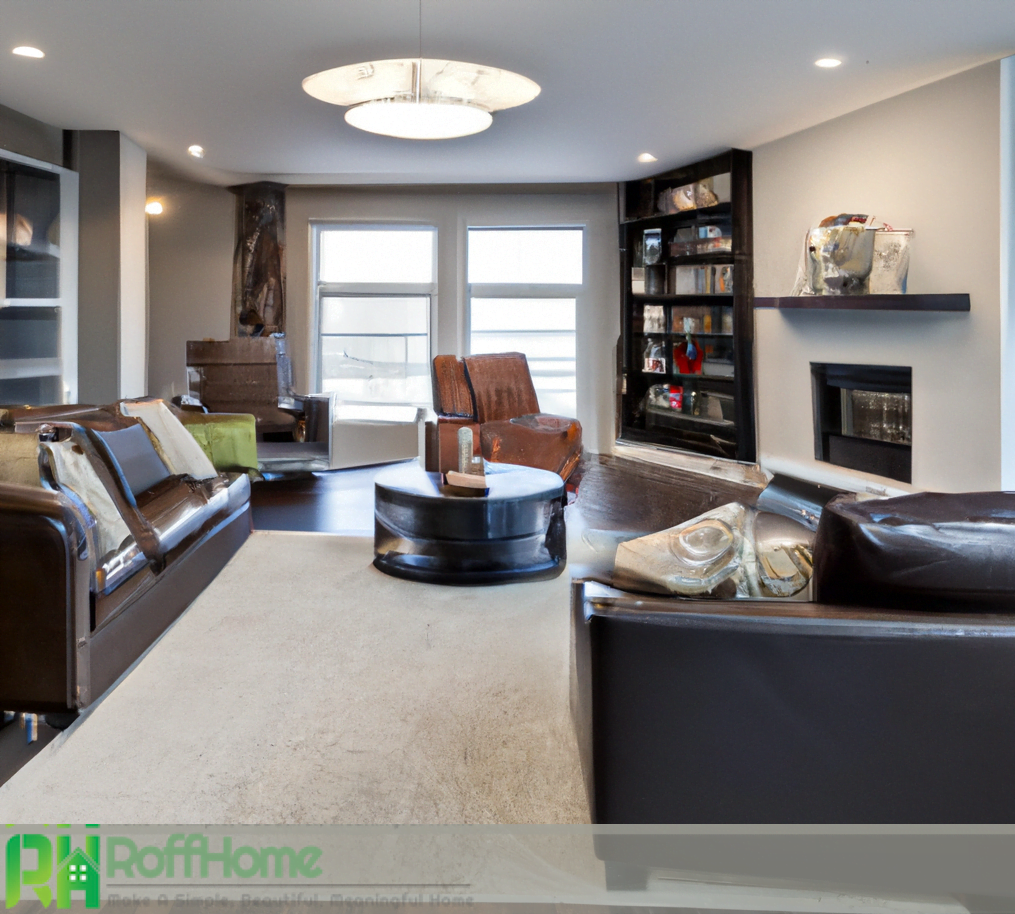
Lighting Design for a Transitional Modern Living Room
The proper lighting design creates a welcoming and inviting atmosphere in a transitional modern living room. It plays a significant role in highlighting key features, setting the mood, and enhancing the overall aesthetics of the space.
Layered Lighting: A layered lighting approach is crucial to achieving a balanced and versatile design. It combines different lighting types, including ambient, task, and accent lighting, to create depth and functionality in the room. Layered lighting allows flexibility in adjusting the intensity and ambiance based on various activities and occasions.
Ambient Lighting: Ambient lighting serves as the room’s primary illumination source, providing overall brightness and a comfortable illumination level. Recessed ceiling, pendant, or track lighting can distribute ambient light evenly throughout the living room. This type of lighting ensures a well-lit space for everyday activities and serves as a foundation for other lighting layers.
Task Lighting: Task lighting focuses on areas or tasks within the living room. It provides targeted illumination for reading, working, or playing games. Desk lamps, floor lamps, and adjustable wall sconces are popular choices for task lighting. Position task lights strategically to minimize shadows and glare, ensuring optimal visibility and functionality.
Accent Lighting: Accent lighting highlights architectural features, artwork, or decorative elements in the living room. This type of lighting adds drama and visual interest to the space. Spotlights, track lights, or picture lights can draw attention to focal points, such as a gallery wall or a statement piece of artwork.
Dimmers and Controls: Incorporating dimmers and lighting controls allows for flexibility in adjusting the brightness levels and creating different moods in the living room. Dimmers can customize the lighting according to specific activities or preferences, from bright and energizing to soft and intimate.
Energy Efficiency: Consider energy-efficient lighting options like LED bulbs or fixtures to reduce energy consumption and lower utility bills. LED lights provide long-lasting illumination while offering a range of color temperatures to suit the desired ambiance.
The benefits of using in a transitional modern living room design
A transitional modern living room design offers several benefits, making it a popular choice for homeowners.
Timeless Appeal: One of the main advantages of a modern transitional design is its timeless appeal. By blending traditional and contemporary elements, this style avoids extreme trends and fads, ensuring that the living room remains stylish and relevant for years. It balances classic and modern aesthetics, creating a sophisticated and elegant space.
Versatility: Transitional modern design allows for versatility in decor and furniture choices. It offers flexibility in mixing different textures, patterns, and materials, allowing homeowners to express their style and preferences. This adaptability allows the living room to evolve with changing tastes and trends without requiring a complete redesign.
Seamless Blending: The transitional modern design seamlessly blends traditional and contemporary elements, creating a cohesive and visually pleasing space. It harmonizes different styles, such as pairing traditional architectural features with sleek modern furniture or combining antique pieces with minimalist decor. This blending of styles creates an interesting and unique atmosphere in the living room.
Balance and Harmony: A key aspect of modern transitional design is achieving balance and harmony. This style combines contrasting elements, such as combining warm and cool color palettes or integrating soft and bold textures. The result is a transitional modern living room that feels visually balanced and harmonious, promoting a sense of tranquility and comfort.
Functional and Practical: Transitional modern design prioritizes functionality and practicality. The layout and furniture selection is carefully planned to optimize space and create a comfortable living environment. This design style encourages a clutter-free space with smart storage solutions, ensuring the living room is organized and efficient.
Broad Appeal: The modern transitional design has a broad appeal that appeals to a wide range of tastes and preferences. Its ability to bridge different styles and eras makes it an inclusive and adaptable design choice. Whether prefer a more traditional look or a contemporary aesthetic, a transitional modern living room can accommodate various design preferences.
Smooth Transition between Rooms: The modern transitional design allows for a smooth transition between different home areas. Suppose your living room connects to other spaces, such as a dining area or a kitchen. In that case, the modern transitional style ensures a seamless flow and cohesiveness throughout the living space.
In conclusion, a transitional modern living room design combines traditional and contemporary styles, offering a timeless and versatile space. Its seamless blending, balance, functionality, and broad appeal create a harmonious atmosphere that stands the test of time.

